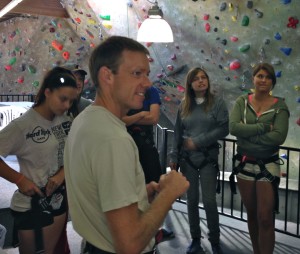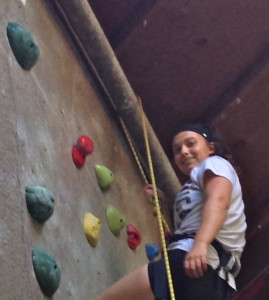By Mike Sullivan, Therapist
 “Belay on!” shouts Johnny, whose legs are shaking and hands trembling as he prepares to climb his first route of the day at the Hangar 18 rock climbing gym in Los Angeles. Moments before this, Johnny had pulled me aside and said, “Mike, I wasn’t kidding when I told you and the group that I am afraid of heights.” Johnny was clearly scared, and with empathic coaching, he was able to approach the wall and begin to climb. This marked the start of the first Pacific Quest student alumni group, held on October 19th.
“Belay on!” shouts Johnny, whose legs are shaking and hands trembling as he prepares to climb his first route of the day at the Hangar 18 rock climbing gym in Los Angeles. Moments before this, Johnny had pulled me aside and said, “Mike, I wasn’t kidding when I told you and the group that I am afraid of heights.” Johnny was clearly scared, and with empathic coaching, he was able to approach the wall and begin to climb. This marked the start of the first Pacific Quest student alumni group, held on October 19th.
Prior to getting started on the climbing, Johnny and his peers participated in “ground school,” where they learned important climbing commands used to ensure safety between the climber and the belayer (the one in charge of rope). Johnny had let the group know about his fear of heights, a sign that he was practicing a valuable tool from his stay at Pacific Quest– expressing his feelings. Johnny’s expression of fear was met with support from the alumni climbing group, which in this instance were a mishmash of Pacific Quest alumni from the past two years ranging from ages 16-23. Most alumni knew one or two others present in the group, yet many were meeting each other for the first time. While the alumni were new to each other in many ways, these kids had a deeper bond present before even stepping foot into the climbing gym – they had the shared experience of graduating from Pacific Quest, a challenging outdoor therapeutic program in Hawaii. They knew what it meant to step outside your comfort zone and challenge limiting self-beliefs. They knew what it meant to take healthy risks and gain a sense of accomplishment and self efficacy from doing so. They were hungry for more.
outdoor therapeutic program in Hawaii. They knew what it meant to step outside your comfort zone and challenge limiting self-beliefs. They knew what it meant to take healthy risks and gain a sense of accomplishment and self efficacy from doing so. They were hungry for more.
“You can do it, Johnny!” the group shouted as Johnny slowly sought out the delicate placement of each foot and the proper hand holds to remain attached to the climbing wall. Johnny shouted back down to the group, “I don’t know you guys……” sharing his reluctance as he ascended the wall, well above the floor of the climbing gym. Johnny was secured by a climbing rope and thus 100% safe, yet when one gets far enough off the ground, even the sense of safety from the rope diminishes. One quickly learns that you can’t rely on the “logic” of the rope system solely. Climbing requires people to draw on an innate sense of confidence, overcome fear, and work through self doubt in the moment. It demands that one build trust with their partner and draw on the support of the group. While Johnny understood from the lessons of the “ground school,” that he was completely safe, he ultimately had to reach deep inside himself and reach out to his peer group to find his way.
Johnny’s group shared encouraging cheers as he continued up the climbing wall. Johnny surmounted the route and slapped his hand on the top of wall signaling victory. “Take!” Johnny shouted, alerting his climbing partner below to draw in any excess slack in the rope and begin lowering him off the route. Johnny was lowered to ground and met with high fives and compliments from his peers. Johnny and his peers proceeded to climb several routes and socialize throughout the climbing gym. All expressed what a fabulous time they had at the event.